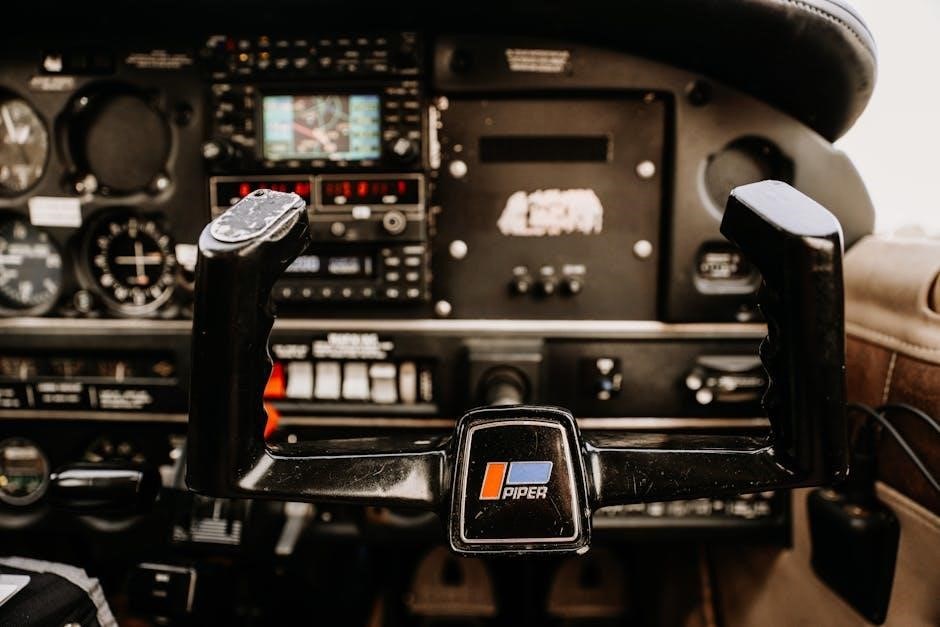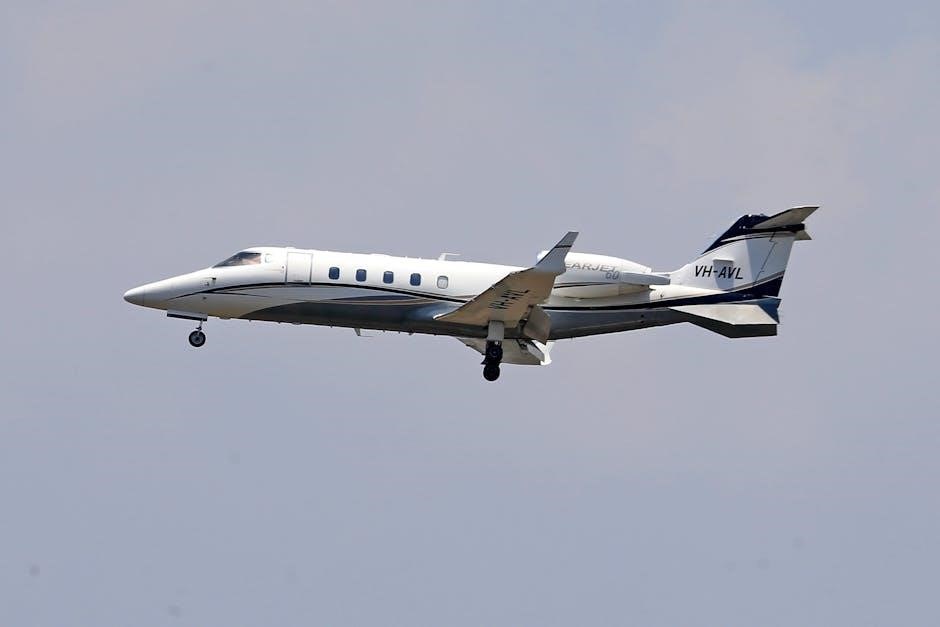Guided Flight Discovery (GFD) is an innovative, application-oriented approach to pilot training, focusing on understanding and applying aeronautical concepts. It uses engaging graphics and real-world scenarios to simplify complex topics for aspiring private pilots.
The Private Pilot Manual
The Private Pilot Manual is a comprehensive, full-color textbook that serves as the primary study resource for aspiring pilots. It covers key topics like flight fundamentals, weather, navigation, and operations in an engaging, easy-to-understand format.
2.1 Fundamentals of Flight
The Fundamentals of Flight section in the Guided Flight Discovery system introduces essential concepts critical for understanding how aircraft operate. It covers the four forces of flight—lift, weight, thrust, and drag—and explains how they interact during various flight regimes. Students learn about aerodynamics, including the shape of wings and how air flows over them to generate lift. The section also delves into aircraft control surfaces, such as ailerons, elevators, and rudders, and their roles in achieving desired flight attitudes and movements. Additionally, it explores basic aircraft performance factors like climb, cruise, and descent, providing a solid foundation for future training. Practical examples and visuals help students grasp these complex topics, making the learning process engaging and effective. This section is vital for building a strong understanding of the principles that govern flight, ensuring pilots can make informed decisions in real-world scenarios. Mastery of these fundamentals is key to safe and efficient flying.
2.2 Flight Operations
The Flight Operations section of the Guided Flight Discovery system provides a detailed overview of the practical aspects of flying. It covers the entire spectrum of flight phases, from pre-flight preparations to post-flight procedures. Students learn about aircraft startup, taxiing, takeoff, climb, cruise, descent, and landing techniques. The section emphasizes the importance of checklist usage, communication with air traffic control, and adherence to standard operating procedures. Practical examples and visuals are included to help students understand real-world scenarios, such as navigating different airport layouts and handling various weather conditions. This module also addresses emergency procedures, ensuring pilots are prepared to respond to unexpected situations. By focusing on both routine and critical operations, the GFD system equips students with the skills and confidence needed to safely and efficiently manage all aspects of flight. This comprehensive approach ensures a smooth transition from training to real-world flying environments.
2.3 Aviation Weather
The Aviation Weather section in the Guided Flight Discovery system is designed to help pilots understand and interpret weather conditions critical to safe flight operations. It covers fundamental concepts such as atmospheric structure, weather patterns, and the impact of weather on aircraft performance. The module includes detailed explanations of weather reports, forecasts, and radar imagery, enabling pilots to make informed decisions. Topics such as fog, icing conditions, thunderstorms, and wind shear are explored in depth, with practical examples illustrating how these phenomena affect flight planning and execution; The GFD system emphasizes the importance of using meteorological tools and resources, such as METARs, TAFs, and AIRMETs, to stay ahead of changing weather conditions. By mastering aviation weather, pilots can enhance safety, minimize delays, and optimize flight routes. This section ensures that future pilots are well-prepared to handle the challenges posed by various weather scenarios, both on the ground and in the air, making it an essential component of the training curriculum.
2.4 Performance and Navigation
The Performance and Navigation section of the Guided Flight Discovery system provides a comprehensive understanding of how to optimize aircraft performance and navigate effectively. It covers key topics such as aircraft performance factors, including takeoff, climb, cruise, and landing, as well as the principles of navigation using both traditional methods and modern tools like GPS. The module emphasizes practical application, teaching pilots how to calculate performance metrics such as range, endurance, and payload capacity. It also explores navigation techniques, including the use of charts, maps, and electronic navigation systems, to ensure accurate and efficient flight planning. Real-world examples and visual aids are used to illustrate complex concepts, making them easier to grasp. This section equips future pilots with the skills to plan and execute flights safely and efficiently, whether flying locally or cross-country. By mastering performance and navigation, pilots can optimize their aircraft’s capabilities and ensure successful outcomes for every flight.
2.5 Integrating Pilot Knowledge
Integrating Pilot Knowledge is a critical component of the Guided Flight Discovery system, designed to help pilots connect the dots between theoretical concepts and practical flying skills. This section emphasizes the importance of synthesizing information from various areas of pilot training, such as weather, navigation, and aircraft performance, into a cohesive understanding. By cross-referencing key topics, pilots can develop a deeper appreciation of how different aspects of aviation interrelate. The GFD system provides tools and exercises that encourage pilots to apply their knowledge in real-world scenarios, ensuring a well-rounded skill set. This integration is essential for building confidence and competence, as it prepares pilots to handle diverse flight conditions and challenges. The ultimate goal is to create a seamless transition from theory to practice, enabling pilots to operate safely and effectively in all phases of flight. This holistic approach to learning is a cornerstone of the Guided Flight Discovery methodology.

The Role of Textbooks and eBooks
Textbooks and eBooks play a vital role in the Guided Flight Discovery system, serving as foundational resources for private pilot training. The GFD Private Pilot Manual, available in both print and digital formats, is a comprehensive guide that covers essential topics such as flight fundamentals, weather, navigation, and performance. Its intuitive organization and vibrant graphics make complex concepts accessible, ensuring that students can grasp the material effectively. eBooks offer added convenience, allowing pilots to study anywhere and access interactive features that enhance learning. These materials are designed to complement flight training, providing a structured path for self-study and review. By leveraging both traditional and modern formats, the GFD system ensures that pilots have the tools they need to succeed in their aviation journey. Whether used in a classroom setting or for independent study, these resources are indispensable for aspiring private pilots aiming to master the skills and knowledge required for certification.

The Importance of the Maneuver Manual
The Maneuver Manual is a cornerstone of the Guided Flight Discovery system, providing detailed, step-by-step descriptions of flight maneuvers required for private pilot training. It is designed to help students visualize and master each procedure, from basic takeoffs to complex landing techniques. With over 100 full-color illustrations, the manual bridges the gap between theory and practice, making it easier for pilots to understand and execute maneuvers confidently. Its clear, concise language ensures that even the most intricate concepts are accessible. The manual also emphasizes safety and precision, aligning with FAA standards and the Practical Test Standards (PTS). By focusing on practical application, it prepares students for real-world flying scenarios, making it an indispensable resource for achieving proficiency and certification. The Maneuver Manual is not just a reference—it’s a hands-on guide that helps pilots develop the skills they need to fly safely and effectively. Its structured approach ensures that no detail is overlooked, making it a vital tool for successful flight training.
Intuitive Organization and Presentation
The Guided Flight Discovery system excels in its intuitive organization and presentation, making complex aviation concepts accessible and engaging. The material is structured logically, with each chapter building on the previous one, ensuring a smooth learning progression. Vibrant, full-color graphics, diagrams, and illustrations are strategically integrated to break down intricate topics into digestible parts. This visual approach enhances understanding and retention, allowing students to grasp key principles quickly. The textbook’s layout is designed to minimize clutter, focusing attention on essential information while maintaining a professional and modern aesthetic. Color-coded sections and clear headings help students navigate the content effortlessly. This intuitive design reduces cognitive load, enabling learners to concentrate on mastering the material rather than deciphering the layout. By combining engaging visuals with a logical structure, Guided Flight Discovery creates an environment where students can focus on their journey to becoming a private pilot.

Cross-References and Study Organization
The Guided Flight Discovery system is designed to enhance study efficiency through its robust cross-referencing framework. This feature ensures that learners can seamlessly connect related concepts across different chapters, fostering a deeper understanding of aviation principles. The manual includes detailed cross-references that direct students to relevant sections, allowing them to review and reinforce previously learned material. This organization minimizes confusion and encourages a structured approach to studying. Additionally, the system provides summary checklists, key terms, and review questions at the end of each chapter, helping students assess their mastery of the content. The integration of cross-references and study aids makes it easier for learners to prepare for exams and practical applications. By organizing the material in a logical and interconnected manner, Guided Flight Discovery supports students in building a strong foundation for their private pilot training. This systematic approach ensures that no concept is studied in isolation, promoting holistic learning and better retention.

Benefits of the GFD System
The GFD system offers enhanced learning through interactive visuals and real-world applications, improving knowledge retention and practical skill development. It equips pilots with comprehensive tools for confident and competent flight operations, ensuring success in aviation training.
7.1 Enhanced Learning Experience
The Guided Flight Discovery (GFD) system delivers an enhanced learning experience by combining interactive visuals with real-world aviation scenarios. Its intuitive organization and colorful presentation make complex topics easier to grasp, engaging students from the start. The system integrates Study Guides that parallel FAA standards, ensuring a structured approach to mastering flight concepts. By focusing on practical applications, GFD helps aspiring pilots connect theory with actual flight operations, fostering a deeper understanding of aviation principles. The inclusion of summaries, checklists, and review questions further reinforces learning, making it easier for students to retain critical information. This comprehensive and engaging method ensures that private pilot candidates are well-prepared for both theoretical and practical aspects of flight training, setting them up for success in their aviation journey.
7.2 Improved Knowledge Retention
The Guided Flight Discovery (GFD) system significantly enhances knowledge retention through its structured approach and engaging methods. By integrating interactive visuals and real-world aviation scenarios, GFD helps students internalize complex concepts more effectively. The system’s logical organization and concise explanations ensure that key information is easily digestible and memorable. Additionally, GFD incorporates review tools such as summaries, checklists, and review questions, which reinforce learning and prevent knowledge gaps. The practical application of concepts further solidifies understanding, making it easier for students to recall critical information during flight training and beyond. This comprehensive approach ensures that private pilot candidates retain the knowledge necessary for safe and competent flight operations, aiding in long-term retention and practical application of aviation skills.
7.3 Practical Application of Concepts
The Guided Flight Discovery (GFD) system emphasizes the practical application of concepts, bridging the gap between theory and real-world aviation. Through detailed maneuvers descriptions and animations, GFD enables students to visualize and execute flight procedures effectively. The manual includes step-by-step guides for essential skills like takeoffs, landings, and navigation, ensuring a smooth transition from classroom learning to actual flight training. Cross-references to FAA standards and practical test requirements further align theoretical knowledge with practical skills. This approach not only builds confidence but also prepares students for real-world scenarios, making them proficient and safe pilots. By focusing on hands-on learning, GFD ensures that private pilot candidates can apply their knowledge seamlessly during flight, enhancing their overall training experience and readiness for certification.
7.4 Comprehensive Coverage of Privileges
The Guided Flight Discovery (GFD) system provides a comprehensive overview of the privileges associated with becoming a private pilot, ensuring students understand their responsibilities and capabilities. It covers the full scope of privileges, including flying in visual meteorological conditions (VMC), carrying passengers, and operating in various airspace environments. The GFD Private Pilot Manual details the rights and limitations of private pilots, such as flight in Class G, E, and other airspace, as well as cross-country and night flying privileges. This section also explores the practical application of these privileges, helping students grasp how to exercise them safely and legally. By aligning with FAA regulations and real-world scenarios, GFD equips future pilots with a clear understanding of their operational freedom, enabling them to fully utilize their certification for recreational or professional pursuits. This comprehensive approach ensures that students are well-prepared to navigate the privileges of private piloting with confidence and compliance.

